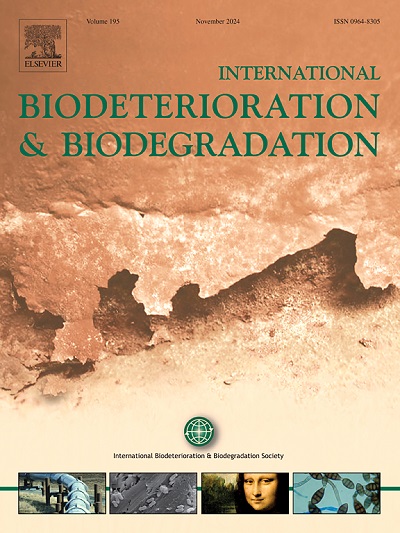Dinitrogen production modes of diverse anammox bacteria and the contribution in nitrogen cycle: A review
IF 4.1
2区 环境科学与生态学
Q2 BIOTECHNOLOGY & APPLIED MICROBIOLOGY
International Biodeterioration & Biodegradation
Pub Date : 2025-05-03
DOI:10.1016/j.ibiod.2025.106113
引用次数: 0
Abstract
Anaerobic ammonia oxidation (anammox) bacteria are lithoautotrophs coupling the oxidation of ammonium with the reduction of nitrite to produce dinitrogen (N2). Anammox reaction is one of the important ones in inorganic nitrogen removal. Here, the reported anammox bacteria, nitrogen metabolism, dinitrogen production modes coupled with other microorganisms, occurrence and contribution in diverse ecosystems were comprehensively summarized. A total of 36 species affiliated to 7 genera of anammox bacteria have been reported. Anammox bacteria use nitrite and nitric oxide as electron acceptors and ammonium as electron donor to carry out anammox reaction. Some also have functional genes required for Dissimilatory nitrate reduction to ammonium (DNRA) process. Anammox bacteria can conduct nitrogen removal via coupling with multiple microorganisms, and realized nitrogen removal via coupling with iron reduction, sulfate reduction, heterotrophic denitrification, sulfur autotrophic denitrification, partial nitrification, denitrifying anaerobic methane oxidation. However, the mechanisms and construction of efficient symbiotic systems consisting of anammox bacteria and other microorganisms is still unclear. Anammox is widespread in ecosystems, and contributes considerable nitrogen yield. Quantification of the nitrogen loss contributed by anammox bacteria in typical ecosystems is an issue in future. Collectively, bacteria have diverse carbon and nitrogen metabolic pathways, and can remove reactive nitrogen species via coupling with other microorganisms, showing a complex and critical robust roles in nitrogen transformation in diverse ecosystems.

厌氧氨氧化菌不同产氮方式及其在氮循环中的贡献综述
厌氧氨氧化(anammox)细菌是一种将氨氧化与亚硝酸盐还原结合产生二氮(N2)的自养生物。厌氧氨氧化反应是无机脱氮的重要反应之一。本文对厌氧氨氧化菌、氮代谢、与其他微生物耦合的二氮生产模式、在不同生态系统中的发生和贡献进行了综述。据报道,厌氧氨氧化菌共7属36种。厌氧氨氧化菌以亚硝酸盐和一氧化氮为电子受体,铵为电子给体进行厌氧氨氧化反应。有些还具有异化硝酸还原成铵(DNRA)过程所需的功能基因。厌氧氨氧化菌通过与多种微生物耦合进行脱氮,并通过与铁还原、硫酸盐还原、异养反硝化、硫自养反硝化、部分硝化、反硝化厌氧甲烷氧化等耦合实现脱氮。然而,厌氧氨氧化菌与其他微生物组成的高效共生系统的机制和构建仍不清楚。厌氧氨氧化在生态系统中广泛存在,并贡献可观的氮产量。对典型生态系统中厌氧氨氧化菌贡献的氮损失进行量化是今后需要解决的问题。总的来说,细菌具有多种碳氮代谢途径,并且可以通过与其他微生物的偶联去除活性氮,在多种生态系统中的氮转化中显示出复杂而关键的强大作用。
本文章由计算机程序翻译,如有差异,请以英文原文为准。
求助全文
约1分钟内获得全文
求助全文
来源期刊
CiteScore
9.60
自引率
10.40%
发文量
107
审稿时长
21 days
期刊介绍:
International Biodeterioration and Biodegradation publishes original research papers and reviews on the biological causes of deterioration or degradation.

 求助内容:
求助内容: 应助结果提醒方式:
应助结果提醒方式:


